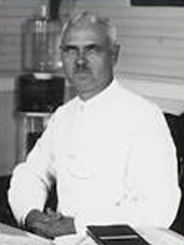
1858 – 1928
"Faith in the ability of a leader is of slight service unless it be united with faith in his justice." Bridging the Atlantic and Pacific Oceans by means of a canal through Panama cost the lives and careers of many men, including Count Ferninand de Lesseps of Suez Canal fame. The task was finally completed by a little known U.S. army Colonel named George Washington Goethals. Goethals and his army of 50,000 workers waged war against heat, disease, mud, and water, finally succeeding in linking the two oceans in 1914.
Goethals was born on June 29, 1858 in Brooklyn to a family of Belgian immigrants. Moving to Manhattan at the age of eleven, the industrious young man worked after school and put himself through three years of study at the College of the City of New York. In 1876 he left before graduating in order to attend the United States Military Academy. Goethals graduated second in his class from West Point 1880, and his experience there provided him a lifelong sense of obligation to public works. As a newly minted second lieutenant in the Corps of Engineers, Goethals worked on dams, bridges, and locks on the Ohio and the Columbia rivers.
In 1885 Goethals returned to West Point in order to teach civil and military engineering. From 1889 to 1894 the restless engineer returned to the field and oversaw the construction of the canals, locks, and dams of the Muscle Shoals project on the Tennessee River. During the Spanish-American War in 1898 Lieutenant Colonel Goethals served as the Chief of Engineers in the First Army Corps, and was assigned to the General Staff of the United States Army from 1903 to 1907. His service on the General Staff gave him significant exposure in Washington, D.C., and in 1907 he was the natural choice by President Theodore Roosevelt for the leadership of the Panama Canal project. Sensitive to the debate concerning whether the canal should be a military or civilian undertaking, the Colonel never wore his uniform in Panama. He took an intense personal interest in the well-being of his men, including an emphasis on sanitation and health. Goethals enjoyed being amongst his workers and routinely toured the zone on a motor-driven car that ran on railroad tracks nicknamed the "Yellow Peril." On Sundays he held informal court sessions, listening to complaints and settling disputes. The atmosphere of cooperation generated by Goethals allowed his team to succeed where others had failed, and the project reached completion six months ahead of schedule.
Upon finishing the canal in 1914, Goethals was honored as a hero, promoted to major general, and retired. With the impending U.S. involvement in World War I, the old soldier was recalled to active duty in 1917 and was named General Manager of the U.S. Shipping Board Emergency Fleet Corporation, then head of the Army's Division of Purchase, Storage, and Traffic, and finally Assistant Chief of Staff in charge of supplies. Goethals was charged with the difficult task of reforming the Army's supply system. He introduced centralized procurement, vertically integrated control, and modern business record keeping and inventory practices. Retired for a second time in 1919, Goethals returned to New York as a consulting engineer. He was one of the Holland Tunnel project's early supporters, and he consulted on the development of the inner harbor of New Orleans and the Columbia Basin irrigation project.

